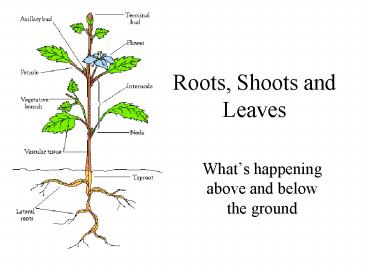Roots, Shoots and Leaves - PowerPoint PPT Presentation
1 / 19
Title:
Roots, Shoots and Leaves
Description:
What about dead trees or trunks that grow new shoots? ... By pinching off the apical stem, it forces buds further down the plant to grow. ... – PowerPoint PPT presentation
Number of Views:108
Avg rating:3.0/5.0
Title: Roots, Shoots and Leaves
1
Roots, Shoots and Leaves
- Whats happening above and below the ground
2
ROOTS
ROOTS ARE NOT PRETTY!
- They do three things and do them well-
- Anchor the plant in the soil
- Absorb water and minerals
- Store excess food for future needs
3
How do roots anchor?
- Fibrous root system
- Small roots take up a large volume of shallow soil
Tap Root System One large root is sent
deep into earth to draw water and nutrients
4
Sometimes, plants will use both systems
5
How is food stored?
- Food is stored especially well in a tap root, due
to its enlarged diameter as well as
length.
6
What controls what type of root is formed?
- WATERplants that get water infrequently will
have deeper roots - WINDplants that have to hang on will have
deeper roots
7
What plant has the longest roots?
- Some desert plants can grow roots 90 feet long!
8
What are those little hairy things?
- They are ROOT HAIRS and their function is to
increase the water intake of the plant while it
is germinating and growing. - They are very easily damaged by transplanting.
9
What is a SHOOT system?
- It consists of everything above the ground.
The apical (or terminal) bud makes the stem grow
longer, starts the leaf growth, and marks spaces
for the (eventual) branches to grow.
The sections of the stem (between buds) are
called nodes.
10
The shoot is responsible for deciding where the
leaves will form so they are not crowded.
11
What about dead trees or trunks that grow new
shoots?
- These come from dormant buds buried deep inside
the bark.
12
How do I use knowledge of buds in gardening?
By pinching off the apical stem, it forces buds
further down the plant to grow. So instead of a 2
foot tall plant, I will have a 1 ½ foot ROUNDER
and MORE FULL bush!
13
What is the purpose of leaves?
- Leaves harvest light (capturing energy) and also
direct falling rain to the stem, and therefore
the roots.
14
Blowing in the wind.
- Leaves are thin enough for sun to pass through
them (allowing photosynthesis to occur in the
greatest number of
cells) - Leaves must be
strong enough to
withstand wind and
precipitation
associated with
severe weather
15
There are several patterns on leaves, which help
to identify plants
Compound leaf
16
Different Compound leaf patterns
Palmately compound leaf
Pinnately compound leaf
17
Other ways to identify leaves
SHAPE
18
Leaf margin (what the sides look like)
19
The difference between roots, shoots and leaves
- Besides the obvious
- LEAVES, once damaged, CANNOT BE REPAIRED!!!
This is why gardeners work so hard to protect
their plants from bugs and other pests!
Leaf attacked by fungus
Leaf attacked by beetles
SLUG IN MY GARDEN!!






























